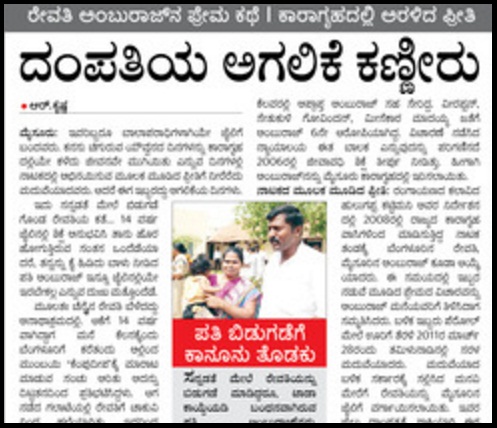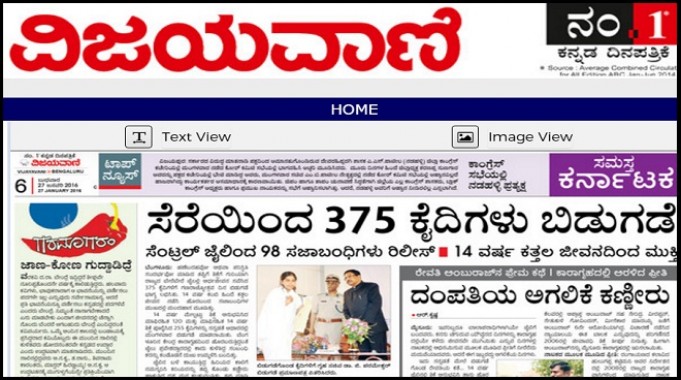When Kannada papers outdid the English press
Vijayvani headline page 6, Jan. 27: 375 convicts released from jail
The release of 375 life convicts from prisons across Karnataka on Republic Day this year was significant and should have been an important human interest story. The norm is that after completing 14 years in jail prisoners can be released on a range of grounds but from 2006 such releases had been deferred. No prisoners were released for eight years leading to overcrowding and mental ailments. Several lists were made but every government postponed taking the decision so more and more prisoners became eligible for release but were not freed.
After 2006 it was only in September 2015 that a few prisoners were released based on their good conduct, and once again a few more in January 2016. While waiting for their release, many who had become eligible for freedom died, and many others lost their mental balance.
In a civilised society, it is necessary to ensure that everybody gets justice. It is only when such news is treated as a human interest story that a positive public opinion about released convicts can be cultivated.
But while major Kannada newspapers published reports that were highly informative, engaging and educative, most English newspapers failed to do so. This is with reference to January 27 Bengaluru edition of the respective newspapers. Readers of Kannada newspapers got a lot of information about the released convicts and how prison stay had made them more sophisticated in their approach to life while barring the Times of India most English newspapers lacked the human touch while dealing with the news.
The analysis here is based on the reports published in the Bengaluru edition of three English newspapers: Deccan Herald, The Hindu and Times of India, and four Kannada newspapers: Kannada Prabha, Vijayavani, Vijay Karnataka and on January 27 and 28.
Deccan Herald buried the two-column Prajavani story with a picture below the fold on page two. Reported like a routine event with the headline: ‘98 jail birds walk free from Central prison’, it displayed little empathy towards prisoners and their sufferings. The lead on the page was about a cleanliness drive in Lalbagh Botanical Garden!
The Hindu carried it as the second lead on page 4 while the lead was about shortage of police personnel in some police stations! The headline ‘Released prisoners head home’ almost read like ‘No water supply tomorrow’. In comparison to the Deccan Herald report The Hindu had some additional points but it failed to impress. However, the reports in the Times of India were far-ranging and touching. Carried under the headline: ‘Released convicts put their past behind’, the reports covered several aspects that Deccan Herald and The Hindu had missed. The Times of Indiagave half the page toit. It dealt with the mood outside the prison when the convicts were being released, profiled a few prisoners, and did a story on how a woman had found love behind those highprison walls.
It also covered how the prison officials had gone the extra mile to trace the family of a released convict to facilitate his reunion. The last one was an exclusive story. It was very clear that the reporter had gone to the spot and had witnessed the event. Compared to The Hindu and Deccan Herald, Times of Indiadefinitely did a better job.
However, Kannada newspapers did the best job. Kannada Prabha in particular. It was the lead on page two. ‘Freed prisoners are theatre artistes’ was the headline. Besides the facts and figures, the reporter explained how among the 375 released prisoners many of them are good theatre artistes and highly educated. It had quotes from an NGO that had conducted theatre workshops for prisoners in the process of which the latter had not only learnt the art but their perspective of life had also changed. The story of six brothers of the same family being released was also quite interesting and an exclusive story.
Vijayavani dedicated half of page 6 for the news. The report captured the first few moments soon after the release of prisoners, details about the achievements of a few of them, profiles of a few and a small story on how for eight years between 2006 and 2015 such release had not happened at all. There was also a story about a woman being released while her husband was not considered for release as he was arrested under the Terrorist and disruptive (Prevention) Act (TADA). Vijayavani carried an exclusive report on Joseph Rodrigues, the man who was convicted for throwing acid on Haseena Hussain in 1999. The crisply writtenstory gave all the details about the crime committed and how the courts dealt with the case.(Here ‘exclusive’ refers to an article that only a particular newspaper carried while none other did.)

The Vijayvani page 6 story on the couple who met and fell in love while in prison
Vijay Karnataka dedicated the space above the fold on page 1 for the story on release of convicts. The space it gave to the story told the readers that here’s something important that has happened. Besides the facts and figures, the report went one step further as the headline suggested that the next move of the government would be to work towards granting premature release for those convicted in dowry harassment and child murder cases. Yet another story profiling some of those released became the anchor on page 2.
In Prajavani, it was the second lead on page 5. Besides facts and figures, it gave details about a few prisoners. However, in comparison to other three Kannada newspapers mentioned here, Prajavani fared poorly.
As if to compensate for the ineffective coverage on the day the news broke, The Hindu in its January 28 edition carried a story that other newspapers had published the previous day: a stale story. It was about a woman prisoner who had found her love in prison. However, there was yet another Mysuru dateline story on page 6 that spoke about Shirin Taj who had returned to the jail after her release as her family had forsaken her. That seemed more like a story that prison officials had given the reporter rather than the person about whom it was.
In their January 28 edition, Prajavani and Deccan Herald did an exclusive story on two released convicts who had to be shifted to the rehabilitation centre for homeless run by the Social Welfare Department at Mache. The report brought out clearly what happens to prisoners if their release is delayed. Ningappa Doddabhimappa Dalwai, a native of Morab in Navalgund in Dharwad district and Suresh Arjappa Annacharti from Gandhinglaj in Kolhapur were already under psychiatric care while they were in prison. Their families had never visited them due to which they had ended up with mental ailments for which they were being treated. Though the article is written in a matter-of-fact way, it brings out the agony of prisoners forsaken by their families, and the mental trauma they face behind those high walls. The authorities of the rehabilitation centre, according to the story, feel helpless and lost. They say that they are trained to look after the homeless, but they do not know how to take care of the two freed convicts with mental ailments.
There are many more Ningappas and Arjappas in prisons across Karnataka who need our attention. Among those languishing in jails are many who are facing the same problems as these two prisoners. One of the main reasons for increase in mental illness in prisoners is the delay caused in the release of eligible prisoners owing to several reasons. The condition of prisons in Karnataka is pathetic, but English daily newspapers hardly have space for it.
The release of life convicts involves a lot of issues that are written about in some Kannada newspapers on a regular basis, but until and unless it is not a press conference story not many English newspapers bother about those issues. Pointing out this fact, a released convict, who walked free on January 26, told this writer that a few Kannada newspapers had consistently carried reports about the positive aspects of life convicts thus impressing upon the high and the mighty that their release is long overdue and should happen fast without further delay.
Hemalatha L. is a freelance journalist and English trainer.
